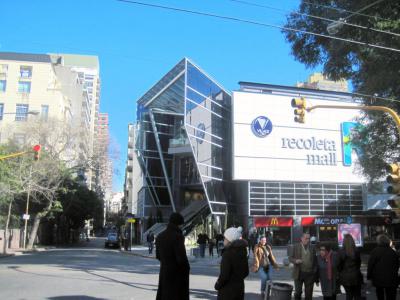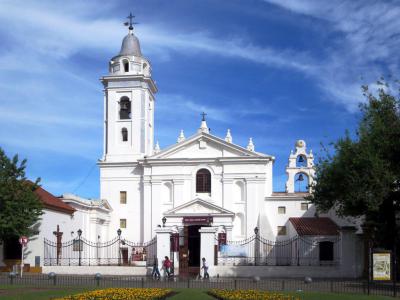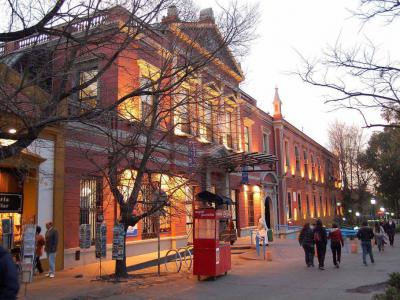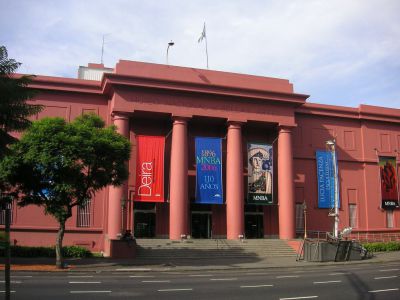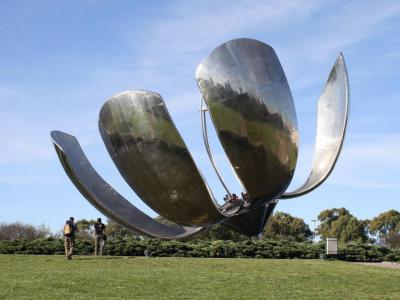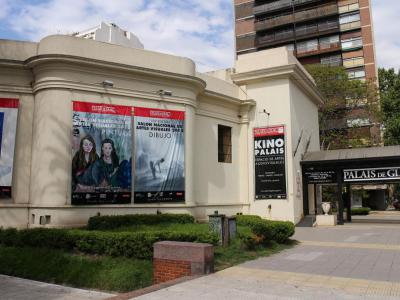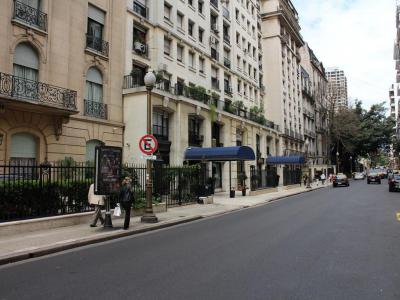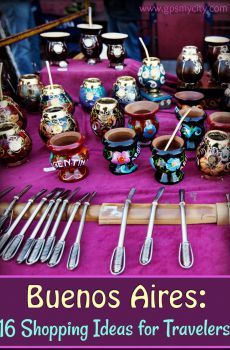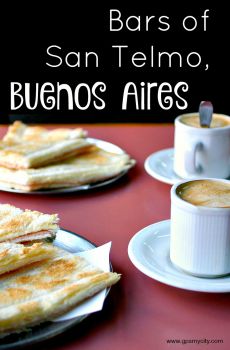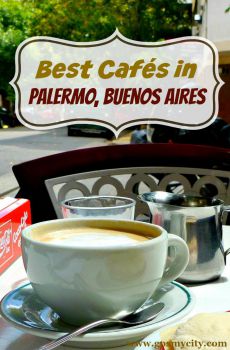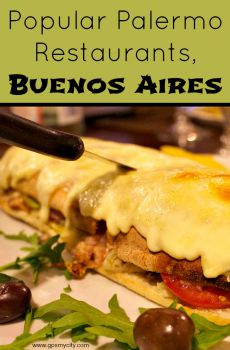Recoleta Neighborhood Walking Tour (Self Guided), Buenos Aires
One of Buenos Aires’ most beautiful neighborhoods, Recoleta is the city’s heart of art and elegance, grace and modernism, culture and leisure. Here you will find lots of things to do, like visiting museums, galleries and cultural centers; relaxing in one of the beautiful parks and plazas; or sampling the delicious local food.
This walking tour along Recoleta begins at the Ateneo Grand Splendid bookstore, which enjoys a suitably grand setting: the former live performance theatre, Teatro Gran Splendid. Aside for the amazing panorama of rows upon rows of books, a visit is worth it to enjoy the preserved Beaux-Art style ornate décor as well as the upper-level balconies from last century.
Nothing is more peculiar about the neighborhood, however, or about Buenos Aires itself, than the seamlessness with which the Recoleta Cemetery has been integrated into the city, and the fact that it is a vibrant, even happy place. A visit there is, yet again, something of an overwhelming experience, with rows upon rows of elaborate mausoleums in just about every architectural style imaginable, jumbled together for almost as far as the eye can see in each direction.
For an impressive panorama of both Argentine and international art from different periods, the National Museum of Fine Arts is definitely worth the time. Combine with a visit to the iconic Floralis Genérica sculpture and the always interesting displays in the Ice Palace, then finish with a stroll down the exclusive Alvear Avenue, where slender apartment buildings and glass towers stand right next to century-old grand homes.
Take this self-guided walking tour to treat yourself to Recoleta’s many cultural attractions while taking in some of the most prominent sights in the metropolis!
This walking tour along Recoleta begins at the Ateneo Grand Splendid bookstore, which enjoys a suitably grand setting: the former live performance theatre, Teatro Gran Splendid. Aside for the amazing panorama of rows upon rows of books, a visit is worth it to enjoy the preserved Beaux-Art style ornate décor as well as the upper-level balconies from last century.
Nothing is more peculiar about the neighborhood, however, or about Buenos Aires itself, than the seamlessness with which the Recoleta Cemetery has been integrated into the city, and the fact that it is a vibrant, even happy place. A visit there is, yet again, something of an overwhelming experience, with rows upon rows of elaborate mausoleums in just about every architectural style imaginable, jumbled together for almost as far as the eye can see in each direction.
For an impressive panorama of both Argentine and international art from different periods, the National Museum of Fine Arts is definitely worth the time. Combine with a visit to the iconic Floralis Genérica sculpture and the always interesting displays in the Ice Palace, then finish with a stroll down the exclusive Alvear Avenue, where slender apartment buildings and glass towers stand right next to century-old grand homes.
Take this self-guided walking tour to treat yourself to Recoleta’s many cultural attractions while taking in some of the most prominent sights in the metropolis!
How it works: Download the app "GPSmyCity: Walks in 1K+ Cities" from Apple App Store or Google Play Store to your mobile phone or tablet. The app turns your mobile device into a personal tour guide and its built-in GPS navigation functions guide you from one tour stop to next. The app works offline, so no data plan is needed when traveling abroad.
Recoleta Neighborhood Walking Tour Map
Guide Name: Recoleta Neighborhood Walking Tour
Guide Location: Argentina » Buenos Aires (See other walking tours in Buenos Aires)
Guide Type: Self-guided Walking Tour (Sightseeing)
# of Attractions: 9
Tour Duration: 2 Hour(s)
Travel Distance: 3.4 Km or 2.1 Miles
Author: irenes
Sight(s) Featured in This Guide:
Guide Location: Argentina » Buenos Aires (See other walking tours in Buenos Aires)
Guide Type: Self-guided Walking Tour (Sightseeing)
# of Attractions: 9
Tour Duration: 2 Hour(s)
Travel Distance: 3.4 Km or 2.1 Miles
Author: irenes
Sight(s) Featured in This Guide:
- El Ateneo Grand Splendid Bookstore
- Recoleta Mall
- Recoleta Cemetery
- Iglesia Nuestra Señora del Pilar (Basilica of Our Lady of the Pillar)
- Recoleta Cultural Centre
- National Museum of Fine Arts
- "Floralis Genérica" Sculpture
- Palais de Glace (Ice Palace)
- Avenida Alvear (Alvear Avenue)
1) El Ateneo Grand Splendid Bookstore (must see)
El Ateneo Grand Splendid Bookstore is often referred to as the world's most beautiful bookstore. Housed in the former Grand Splendid theater, El Ateneo Grand Splendid Bookstore retains the beauty of the original Beaux-Arts building.
The original theatre first opened in 1919 and hosted opera, ballet, tango performances, and film premiers. The old theatre was converted into a bookstore in 2000. The original dome, painted by Italian Nazaeron Orlandi, remains. A cafe sits on the theatre's old stage. Here, you can buy a coffee, tea, or a snack while reading and admiring the decor.
You'll find children's books in the basement and exhibitions on the upper floor. Soft lighting and comfortable chairs invite visitors to pick out a book and enjoy the read and surroundings.
The original theatre first opened in 1919 and hosted opera, ballet, tango performances, and film premiers. The old theatre was converted into a bookstore in 2000. The original dome, painted by Italian Nazaeron Orlandi, remains. A cafe sits on the theatre's old stage. Here, you can buy a coffee, tea, or a snack while reading and admiring the decor.
You'll find children's books in the basement and exhibitions on the upper floor. Soft lighting and comfortable chairs invite visitors to pick out a book and enjoy the read and surroundings.
2) Recoleta Mall
The Recoleta Mall (formerly known as "Village Recoleta") is a popular theater and shopping complex in Buneos Aires. It is located near the embassies, the Barrio Norte, a wealthy neighborhood with upscale shops and restaurants.
The Recoleta Mall is located opposite the walls of the Recoleta Cemetery. The theaters screen Hollywood blockbusters and films from Brazil, France and Spain. It has a quaint front plaza, a fountain and plenty of benches for tired shoppers to rest their feet. The ground floor houses restaurants with plenty of outdoor seating where customers can enjoy a snack or meal while watching the world go by.
The lobby of the building has a magnificent staircase that leads to the theaters. The lobby has a Cupside book store which is a branch of a popular book store chain in Buenos Aires. There are also pizzerias, cafes and bar type restaurants with indoor seating across the Cupside store. Movie tickets are sold upstairs and there are music shops and fast food restaurants include McDonalds on the upper floor. The theater sections offers a variety of viewing opportunities with 16 screens showing diverse movies in the upper three floors of the building. Popcorn, candy and other snacks enjoyed by movie goers are available on both floors. Recoleta Mall is a popular Buenos Aires destination for movie goers and discriminating shoppers.
The Recoleta Mall is located opposite the walls of the Recoleta Cemetery. The theaters screen Hollywood blockbusters and films from Brazil, France and Spain. It has a quaint front plaza, a fountain and plenty of benches for tired shoppers to rest their feet. The ground floor houses restaurants with plenty of outdoor seating where customers can enjoy a snack or meal while watching the world go by.
The lobby of the building has a magnificent staircase that leads to the theaters. The lobby has a Cupside book store which is a branch of a popular book store chain in Buenos Aires. There are also pizzerias, cafes and bar type restaurants with indoor seating across the Cupside store. Movie tickets are sold upstairs and there are music shops and fast food restaurants include McDonalds on the upper floor. The theater sections offers a variety of viewing opportunities with 16 screens showing diverse movies in the upper three floors of the building. Popcorn, candy and other snacks enjoyed by movie goers are available on both floors. Recoleta Mall is a popular Buenos Aires destination for movie goers and discriminating shoppers.
3) Recoleta Cemetery (must see)
Set in five and a half acres of land, the Recoleta Cemetery is referred to as the City of the Dead. Many of the gravestones and vaults are works of art and 94 have been declared as National Historic Monuments.
In the 18th century, the monks of the order of Recoletos built the church of Our Lady of Pilar. In 1822 the garden of the church was converted into a public cemetery by architect and civil engineer, Prospero Catelin. The entrance is through neoclassical styled gates with Doric columns. It hosts over 4600 graves and some of them are elaborate marble mausoleums. The layout is like a city with blocks, stone streets and small plazas. In 1881, the streets and the chapel were renovated and extensive maintenance of the sculptures and statues were carried out.
The Recoleta Cemetery is the final resting place of most Argentine Presidents and eminent personalities like Eva Peron, Carlos Guido y Spano (poet), Carlos Saavedra Lamas (the first Latin American Nobel Peace Prize Winner) and Victoria Ocampo (writer). The entrance ticket price is $20 (30ARS) for foreign visitors. Free guided tours of the cemetery are conducted in English on Tuesdays and Thursdays, at 11.00 am. Visitors can purchase maps and take a self-guided tour around the graves and mausoleums of eminent Argentines.
In the 18th century, the monks of the order of Recoletos built the church of Our Lady of Pilar. In 1822 the garden of the church was converted into a public cemetery by architect and civil engineer, Prospero Catelin. The entrance is through neoclassical styled gates with Doric columns. It hosts over 4600 graves and some of them are elaborate marble mausoleums. The layout is like a city with blocks, stone streets and small plazas. In 1881, the streets and the chapel were renovated and extensive maintenance of the sculptures and statues were carried out.
The Recoleta Cemetery is the final resting place of most Argentine Presidents and eminent personalities like Eva Peron, Carlos Guido y Spano (poet), Carlos Saavedra Lamas (the first Latin American Nobel Peace Prize Winner) and Victoria Ocampo (writer). The entrance ticket price is $20 (30ARS) for foreign visitors. Free guided tours of the cemetery are conducted in English on Tuesdays and Thursdays, at 11.00 am. Visitors can purchase maps and take a self-guided tour around the graves and mausoleums of eminent Argentines.
4) Iglesia Nuestra Señora del Pilar (Basilica of Our Lady of the Pillar)
The Basilica of Our Lady of the Pillar in Buenos Aires' Recoleta neighborhood is a vital part of the Franciscan monastery. It was built through a collaborative effort led by architect Andrés Blanqui and finished by Juan Bautista Prímoli. This stunning basilica, devoted to Our Lady of the Pillar, was completed in 1732.
Architecturally, the exterior of the basilica is characterized by a modest yet elegant colonial design, boasting a whitewashed appearance. Inside, it holds a treasure trove of exquisite original altarpieces and decorative elements.
The Basilica was tied to the Recollects friar order, inspiring the Recoleta neighborhood's name. It was built on the city's edge, reflecting the order's solitude ideals. The funds for the basilica's construction were generously provided by a resident hailing from Zaragoza, Spain. This contribution came with the stipulation that the church be dedicated to the Virgin of the Pillar, a revered manifestation of the Virgin Mary closely associated with Zaragoza.
The architectural layout of the church features a single central nave intersected by a transept, its graceful curvature covered by a sail vault. Adjacent to the nave are shallow side chapels that add to the grandeur of the space. Of particular note is the baroque-style main altarpiece, a remarkable masterpiece adorned with Inca-inspired motifs and silver craftsmanship from Peru.
The stylistic elements of the pulpit and side altars also exhibit a distinct baroque influence. The intricate 18th-century woodwork is credited to the skilled sculptor Alonso Cano. Additionally, the altar housing relics is believed to have been a bestowed gift from King Carlos III of Spain.
Why You Should Visit:
There are lots of gold-leaf used inside to good effect and a gold Madonna on the altar which is the focal point.
On weekends the plaza in front fills with craft, art, and food stalls and becomes a popular marketplace.
Tip:
The historic cloisters are open at set times (check info board outside) and you will be asked for a small per-person donation to enter.
Monday - Friday: 7:30 am – 10:00 pm; Saturday and Sunday: 8:00 am – 10:00 pm.
Architecturally, the exterior of the basilica is characterized by a modest yet elegant colonial design, boasting a whitewashed appearance. Inside, it holds a treasure trove of exquisite original altarpieces and decorative elements.
The Basilica was tied to the Recollects friar order, inspiring the Recoleta neighborhood's name. It was built on the city's edge, reflecting the order's solitude ideals. The funds for the basilica's construction were generously provided by a resident hailing from Zaragoza, Spain. This contribution came with the stipulation that the church be dedicated to the Virgin of the Pillar, a revered manifestation of the Virgin Mary closely associated with Zaragoza.
The architectural layout of the church features a single central nave intersected by a transept, its graceful curvature covered by a sail vault. Adjacent to the nave are shallow side chapels that add to the grandeur of the space. Of particular note is the baroque-style main altarpiece, a remarkable masterpiece adorned with Inca-inspired motifs and silver craftsmanship from Peru.
The stylistic elements of the pulpit and side altars also exhibit a distinct baroque influence. The intricate 18th-century woodwork is credited to the skilled sculptor Alonso Cano. Additionally, the altar housing relics is believed to have been a bestowed gift from King Carlos III of Spain.
Why You Should Visit:
There are lots of gold-leaf used inside to good effect and a gold Madonna on the altar which is the focal point.
On weekends the plaza in front fills with craft, art, and food stalls and becomes a popular marketplace.
Tip:
The historic cloisters are open at set times (check info board outside) and you will be asked for a small per-person donation to enter.
Monday - Friday: 7:30 am – 10:00 pm; Saturday and Sunday: 8:00 am – 10:00 pm.
5) Recoleta Cultural Centre
The Recoleta Cultural Centre (Centro Cultural Recoleta) is an arts and cultural venue in Buenos Aires managed by an organization called the Friends of the Centro Cultural Recoleta under the aegis of the Ministry of Culture. It is housed in a historical building that was once a Franciscan Convent.
The building where the cultural center is located was originally donated to the Franciscans in 1716. The blueprints of the construction were drawn by Jesuit architects Juan Krauss and Juan Wolf, while the design of the façade and interiors are attributed to Andrés Blanqui.
The building, finished in 1732, is one of the oldest in the city. With the arrival of the May Revolution and the declaration of independence during the first part of the 19th century, the building changed purposes. Manuel Belgrano founded a drawing school there, and since the 1870s it served as a shelter for the destitute. Torcuato de Alvear, first mayor of Buenos Aires, beautified Recoleta as well as the cultural centre; Juan Antonio Buschiazzo gave it an Italian style and created the chapel currently used as an auditorium.
Today, the Centro Cultural Recoleta holds sculptures and exhibitions, as well as concerts and artistic presentations and workshops of diverse types.
Why You Should Visit:
Dozens of exhibitions running at the same time, from modern to avant-garde (including a variety of areas for paintings, sculpture, drawings, photography, etc.), and mostly by Argentines – a nice change from other museums where the European-ish flavor dominates. Most of the time, two or three of the exhibitions are just amazing. For a free entrance place, it's all in all quite marvelous.
Tip:
Great place to go on the weekends, as there's always something interesting to do/try/see/experience. Events mostly happen during the evening-night time.
The building where the cultural center is located was originally donated to the Franciscans in 1716. The blueprints of the construction were drawn by Jesuit architects Juan Krauss and Juan Wolf, while the design of the façade and interiors are attributed to Andrés Blanqui.
The building, finished in 1732, is one of the oldest in the city. With the arrival of the May Revolution and the declaration of independence during the first part of the 19th century, the building changed purposes. Manuel Belgrano founded a drawing school there, and since the 1870s it served as a shelter for the destitute. Torcuato de Alvear, first mayor of Buenos Aires, beautified Recoleta as well as the cultural centre; Juan Antonio Buschiazzo gave it an Italian style and created the chapel currently used as an auditorium.
Today, the Centro Cultural Recoleta holds sculptures and exhibitions, as well as concerts and artistic presentations and workshops of diverse types.
Why You Should Visit:
Dozens of exhibitions running at the same time, from modern to avant-garde (including a variety of areas for paintings, sculpture, drawings, photography, etc.), and mostly by Argentines – a nice change from other museums where the European-ish flavor dominates. Most of the time, two or three of the exhibitions are just amazing. For a free entrance place, it's all in all quite marvelous.
Tip:
Great place to go on the weekends, as there's always something interesting to do/try/see/experience. Events mostly happen during the evening-night time.
6) National Museum of Fine Arts (must see)
The National Museum of Arts, locally known as Museo Nacional de Bellas Artes, is an art museum that was established in 1896. The museum was originally held in the Bon Marche store building, but moved to its current location in 1933.
The museum's building once served as a pump house in the Recoleta neighborhood. Originally built in 1870, it was remodeled by architect Alejandro Bustillo to make room for the ever-growing collection.
The museum offers fine art from around the world as well as a vast array of works from Argentine artists. Masterpieces in the collection come from renowned painters like Monet, El Greco, Rembrandt, Gaughin and Van Gogh.
Patrons can see paintings, sculptures and photography on display in the museum's permanent exhibit. They can also find temporary exhibits that rotate every three to six months.
Along with art pieces, the National Museum of Arts holds a vast library and a public auditorium. It also has a gift shop that is open during all museum hours.
The museum is open Thursday through Sunday from noon to 7 PM.
The museum's building once served as a pump house in the Recoleta neighborhood. Originally built in 1870, it was remodeled by architect Alejandro Bustillo to make room for the ever-growing collection.
The museum offers fine art from around the world as well as a vast array of works from Argentine artists. Masterpieces in the collection come from renowned painters like Monet, El Greco, Rembrandt, Gaughin and Van Gogh.
Patrons can see paintings, sculptures and photography on display in the museum's permanent exhibit. They can also find temporary exhibits that rotate every three to six months.
Along with art pieces, the National Museum of Arts holds a vast library and a public auditorium. It also has a gift shop that is open during all museum hours.
The museum is open Thursday through Sunday from noon to 7 PM.
7) "Floralis Genérica" Sculpture (must see)
The environmental kinetic sculpture Floralis Genérica was a gift to the city of Buenos Aires by architect, Eduardo Catalano. It opens every day at 8 a.m. to symbolize hope.
Eduardo Catalano was born in Buenos Aires and commissioned the Lockheed Airplane factory to fabricate the large flower based on his design. It was his gift to the city of his birth. No particular flower is depicted and it is a generic floral design that symbolizes all flowers. It is 23 meters high and stands at the center of a park above a reflecting pool. The paths around the sculpture are designed to give different perspectives of the structure. It has six petals that are 13 meters long and 7 meters wide.
An electrical mechanism automatically opens (morning) and closes (evening) the Floralis Genérica. A red light glows from inside the closed flower. It opens again in the morning depicting renewed hope. The opening process takes 20 minutes. The petals are also closed when strong winds blow as a protective measure. On May 25th, September 21st, Christmas Eve and New Year's Eve, the petals remain open all night and are illuminated by red floodlights. Green lights illuminate the paths around the sculpture giving it a spectacular effect on these special nights.
Why You Should Visit:
To witness a unique example of what a modern sculpture can contribute to the beauty of a city.
Grand in scale, eloquent in design, photographs well. Lovely open parkland surroundings.
Tip:
Try to visit in the morning as the sun rises to see the petals open up.
Eduardo Catalano was born in Buenos Aires and commissioned the Lockheed Airplane factory to fabricate the large flower based on his design. It was his gift to the city of his birth. No particular flower is depicted and it is a generic floral design that symbolizes all flowers. It is 23 meters high and stands at the center of a park above a reflecting pool. The paths around the sculpture are designed to give different perspectives of the structure. It has six petals that are 13 meters long and 7 meters wide.
An electrical mechanism automatically opens (morning) and closes (evening) the Floralis Genérica. A red light glows from inside the closed flower. It opens again in the morning depicting renewed hope. The opening process takes 20 minutes. The petals are also closed when strong winds blow as a protective measure. On May 25th, September 21st, Christmas Eve and New Year's Eve, the petals remain open all night and are illuminated by red floodlights. Green lights illuminate the paths around the sculpture giving it a spectacular effect on these special nights.
Why You Should Visit:
To witness a unique example of what a modern sculpture can contribute to the beauty of a city.
Grand in scale, eloquent in design, photographs well. Lovely open parkland surroundings.
Tip:
Try to visit in the morning as the sun rises to see the petals open up.
8) Palais de Glace (Ice Palace)
The Palais de Glace, or Ice Palace, is a conference center in the Recoleta neighborhood of Buenos Aires. It was designed by architect J. L. Ruiz Basadre who modeled the building after the Palais des Glaces in Paris. Construction of the building was completed in 1911.
The Ice Palace was initially built as an ice skating rink and social club. In the 1920s, the building was converted into a dance hall where the tango was popularly performed.
By 1931, the building was used by the Ministry of Education and Justice as a home to the Salón Nacional de Bellas Artes, or National Exhibition of Fine Arts. It also hosted a television studio from 1954 through 1960.
Today, it remains a home to the Salon Nacionel and also hosts other art and music events. The Palais de Glace was named a National Historic Monument in 2004.
Visitors will find the Palais de Glace in Recoleta between the Parque Thays and the Plaza Martin de Tours.
The Ice Palace was initially built as an ice skating rink and social club. In the 1920s, the building was converted into a dance hall where the tango was popularly performed.
By 1931, the building was used by the Ministry of Education and Justice as a home to the Salón Nacional de Bellas Artes, or National Exhibition of Fine Arts. It also hosted a television studio from 1954 through 1960.
Today, it remains a home to the Salon Nacionel and also hosts other art and music events. The Palais de Glace was named a National Historic Monument in 2004.
Visitors will find the Palais de Glace in Recoleta between the Parque Thays and the Plaza Martin de Tours.
9) Avenida Alvear (Alvear Avenue)
Avenida Alvear, or Alvear Avenue, is a thoroughfare in the Recoleta neighborhood of Buenos Aires. The avenue offers many examples of early-20th century architecture that was primarily influenced by French culture. The avenue runs from the Embassy of France to the Plaza Dante.
Construction of the avenue began in 1885 at the behest of the first mayor of Buenos Aires, Torcuato de Alvear. He made his mark on the city by improving streets, electricity and public transport. The avenue that bears his name has been called one of the most distinguished avenues in the world.
Among the notable buildings along Avenida Alvear are the French Embassy, the Brazilian Embassy, Hume House and the Alvear Palace Hotel. Recoleta Cemetery is easily reached via Avendia Alvear as well.
Visitors to the avenue will find a number of art galleries, luxury eateries and boutique shops like Hermes and Omega. However, most tourists will simply enjoy the elegant architecture that lines the streets.
Construction of the avenue began in 1885 at the behest of the first mayor of Buenos Aires, Torcuato de Alvear. He made his mark on the city by improving streets, electricity and public transport. The avenue that bears his name has been called one of the most distinguished avenues in the world.
Among the notable buildings along Avenida Alvear are the French Embassy, the Brazilian Embassy, Hume House and the Alvear Palace Hotel. Recoleta Cemetery is easily reached via Avendia Alvear as well.
Visitors to the avenue will find a number of art galleries, luxury eateries and boutique shops like Hermes and Omega. However, most tourists will simply enjoy the elegant architecture that lines the streets.
Walking Tours in Buenos Aires, Argentina
Create Your Own Walk in Buenos Aires
Creating your own self-guided walk in Buenos Aires is easy and fun. Choose the city attractions that you want to see and a walk route map will be created just for you. You can even set your hotel as the start point of the walk.
Buenos Aires Introduction Walking Tour
Buenos Aires, the capital of Argentina, has a history marked by exploration, colonial rivalry, mass immigration, and political change. Its name derives from the Spanish dedication “Our Lady Saint Mary of the Good Air,” a title of the Virgin Mary venerated by sailors from Sardinia. The phrase “Buen Aire” originally referred to the clean, favorable winds near a sanctuary in the city of... view more
Tour Duration: 2 Hour(s)
Travel Distance: 4.7 Km or 2.9 Miles
Tour Duration: 2 Hour(s)
Travel Distance: 4.7 Km or 2.9 Miles
Palermo Area Walking Tour
Situated just back from one of the main thoroughfares, Santa Fe Avenue (Avenida Santa Fe), Palermo is a relaxed and culturally delightful area full of restaurants, cafes, and wall murals. The tree-lined streets are shady and many of the older Spanish-style houses were converted into small shops without compromising their original character. It’s an excellent place in which to sample the city’s... view more
Tour Duration: 2 Hour(s)
Travel Distance: 3.5 Km or 2.2 Miles
Tour Duration: 2 Hour(s)
Travel Distance: 3.5 Km or 2.2 Miles
May Avenue Walking Tour
May Avenue is one of Buenos Aires’ most emblematic boulevards, a grand east–west axis that reflects the city’s political, cultural, and architectural evolution. Its name honors the May Revolution of 1810, when residents of Buenos Aires removed the Spanish viceroy and initiated the process that ultimately led to Argentina’s independence.
Plans for a monumental boulevard connecting the... view more
Tour Duration: 2 Hour(s)
Travel Distance: 2.3 Km or 1.4 Miles
Plans for a monumental boulevard connecting the... view more
Tour Duration: 2 Hour(s)
Travel Distance: 2.3 Km or 1.4 Miles
Useful Travel Guides for Planning Your Trip
Buenos Aires: 16 Shopping Ideas for Travelers
Other than a cool place to be and a dream destination for many adventure-minded folk, Buenos Aires is a great culture hub where one can experience first-hand all that Argentina has to offer - great football, terrific wine, killer steaks, and much much more. This guide is to help you steer yourself...
Top 5 Bars in San Telmo, Buenos Aires
With its cobbled streets, colonial era buildings and vibrant music and art scene, San Telmo is a great place to soak up the eclectic nature of Buenos Aires’ nightlife. The area boasts dozens of bars and cafes, with some of the city’s oldest lying next to the more modern. Indeed, San Telmo...
Top 7 Cafes in Palermo, Buenos Aires
The word "Palermo", believe it or not, may refer not just to Sicily, Italy, but also to Buenos Aires, Argentina. Indeed, this neighborhood (barrio) is largest in the city and is trendy and bohemian, renowned for its boutique shopping, cafes, restaurants, bars, and nightclubs. Oftentimes,...
Popular Palermo Restaurants, Buenos Aires
Although many visitors tend to think that Argentina is a meat and potatoes country, the rich cultural heritage from Italy, Spain, Portugal, and other European countries provide a veritable smorgasboard of dining options. Palermo is the barrio in Buenos Aires often referred to as 'The Restaurant...
The Most Popular Cities
/ view all




